 When Screen Cartoonists Guild Local 841 met on December 8, 1953 at the Hotel Claridge, they had much to discuss. N.B.C. Network just contracted with the union. Famous Studios invading the TV commercial market caused a big concern. There was also the matter of their Group Life Insurance Plan, along with the induction of seventeen new members. Three of those initiates had been friends at the High School of Industrial Arts in Manhattan.
When Screen Cartoonists Guild Local 841 met on December 8, 1953 at the Hotel Claridge, they had much to discuss. N.B.C. Network just contracted with the union. Famous Studios invading the TV commercial market caused a big concern. There was also the matter of their Group Life Insurance Plan, along with the induction of seventeen new members. Three of those initiates had been friends at the High School of Industrial Arts in Manhattan.
That school provided vocational training to carpenters, technicians, machinists, and boasted a top-notch commercial art department. Phil Kimmelman, entering his Junior semester in 1951, made good use of it. Phil’s dad owned a grocery store in Washington Heights where 193rd Street crosses Broadway. His family lived close by, in an apartment opposite Fort Tryon Park. New York’s Botanical Gardens were Phil’s playground.
Phil Kimmelman intended to be a professional cartoonist. He and classmate Howie Klein created the comic strip ROY CITRUS AND HIS SIDEKICK MIAMI about a couple guys just out of the Army who inherit an orange grove. One of Phil and Howie’s teachers must have showed the strip around, because Blue Goose Orange Juice approached them with an offer to buy the characters. They turned the money down.
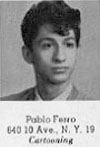 Phil Kimmelman’s other collaborative buddy was Cuban immigrant Pablo Ferro. Pablo’s father had been caught up in Cuba’s volatile political rollercoaster as the Cold War settled upon us. Pablo Ferro found his family exiled to Hell’s Kitchen at age thirteen. He spoke no English. Talent landed the kid in the industrial arts program. Phil adopted Pablo, taking his shaggy-haired friend home to dinner. Mrs. Kimmelman taught Pablo English as she fed the boys and helped them study.
Phil Kimmelman’s other collaborative buddy was Cuban immigrant Pablo Ferro. Pablo’s father had been caught up in Cuba’s volatile political rollercoaster as the Cold War settled upon us. Pablo Ferro found his family exiled to Hell’s Kitchen at age thirteen. He spoke no English. Talent landed the kid in the industrial arts program. Phil adopted Pablo, taking his shaggy-haired friend home to dinner. Mrs. Kimmelman taught Pablo English as she fed the boys and helped them study.
Anyways, Pablo learned English plenty good, plenty fast. He got himself an usher’s job at a foreign cinema theater on 42nd Street. Pablo set to work on a comic book story he was going to sell. He askef Howie Klein to ink it, but didn’t like the results. Pablo Ferro got in the habit of learning how to do everything himself.
Pablo and Phil were best friends. In warmer weather they’d take their books to the park and study on the gardened grounds of the Cloisters museum, overlooking the Hudson River. They wandered through that museum’s collection discussing plans. A generation earlier the career paths opened to a young Jewish man or a Latino refugee would have been more restricted. But it seems engaging in death throes with Nazis and Fascists burned off some of America’s anger. Anti-Semitism and xenophobia had lightened, and new roads were open.

Phil Kimmelman and Pablo Ferro
Phil Kimmelman took first place in a contest where MAD Magazine picked the best cartooning portfolio of a student. Pablo Ferro sold a four page story he’s done to Stan Lee at Atlas Comics. Here they were, bright-futured go-getters, confidently pounding Manhattan’s pavement, Prices of the City! Society shook off its post-war doldrums with an eye towards bigger and better. Phil and Pablo would make art for this bold new world.
And yet, some piece of the formula was missing. Pablo Ferro leaned in a school doorway, mentally dissecting a Disney comic book when student Dante Barbetta approached him. Dante loved animation, especially the stuff done by Disney, idolizing Bill Tytla in particular. Dante and Pablo hit it off. Pablo soon introduced Dante to Phil.
Where Phil and Pablo had settled into the idea of cartooning for comic books or newspapers, Dante insisted cartoons should move. Using his well-thumbed copy of Preston Blair’s book as a guide, Dante brought his friends into his dream of becoming an animator. Pablo went to see a re-release of FANTASIA with Dante. The High School of Industrial Arts had no program about animation then, allowing the three boys to start developing one. Phil and Pablo both plunked down their $1.00 to posses their own copies of Preston Blair’s book.
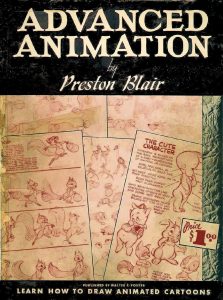 I need to break narrative flow here to give Walter T. Foster a shout out. Foster’s affordable “how to draw” series tutored a generation of American artists. You could find these books, covering a wide variety of themes and styles, on a display rack in any stationary store. (Remember stationary stores?) I had several issues about cartooning and horses. With the knowledge they provided I started drawing Petey the Pirate from the inside of matchbook covers. But that came a bit later. I hadn’t been born yet in 1952. Back then Rosemary Clooney sang BLUES IN THE NIGHT as Alan Freed prepared to spring Rock-N-Roll on an unsuspecting populace. President Truman had U.S. troops fighting in Korea. General MacArthur insisted we unleash atomic weapons. Ike would soon step into the White House and set a new course. All seemed possible.
I need to break narrative flow here to give Walter T. Foster a shout out. Foster’s affordable “how to draw” series tutored a generation of American artists. You could find these books, covering a wide variety of themes and styles, on a display rack in any stationary store. (Remember stationary stores?) I had several issues about cartooning and horses. With the knowledge they provided I started drawing Petey the Pirate from the inside of matchbook covers. But that came a bit later. I hadn’t been born yet in 1952. Back then Rosemary Clooney sang BLUES IN THE NIGHT as Alan Freed prepared to spring Rock-N-Roll on an unsuspecting populace. President Truman had U.S. troops fighting in Korea. General MacArthur insisted we unleash atomic weapons. Ike would soon step into the White House and set a new course. All seemed possible.
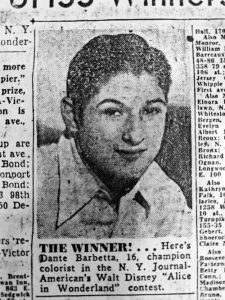 Dante Barbetta’s claim to fame stemmed from having won first place in a Disney-sponsored art contest promoting the film ALICE IN WONDERLAND. His family lived in an apartment at 103-105 Havemeyer Street, Brooklyn. The Disney prize brought in $2,000. With Pablo as best man, Dante married a nice Italian girl. His father was a factory worker who’d become ill, so Dante left school to work as a handyman’s assistant.
Dante Barbetta’s claim to fame stemmed from having won first place in a Disney-sponsored art contest promoting the film ALICE IN WONDERLAND. His family lived in an apartment at 103-105 Havemeyer Street, Brooklyn. The Disney prize brought in $2,000. With Pablo as best man, Dante married a nice Italian girl. His father was a factory worker who’d become ill, so Dante left school to work as a handyman’s assistant.
Pablo sold a couple more short comic book stories to Stan Lee, spending that money on an 8mm movie camera capable of capturing one-frame-at-a-time. Phil Kimmelman had a job behind a soda fountain near home. Phil won a three year scholarship to the School of Visual Arts, active upon graduating High School. (Rudy Zamora’s nephew came in second.) Our talented trio rented a storefront in Brooklyn to start their own animation studio.
The place never had a name. The exact location is long-since forgotten, aside from being within walking distance of Dante’s apartment, where Mrs. Barbetta often had delicious homemade pizza on the table.
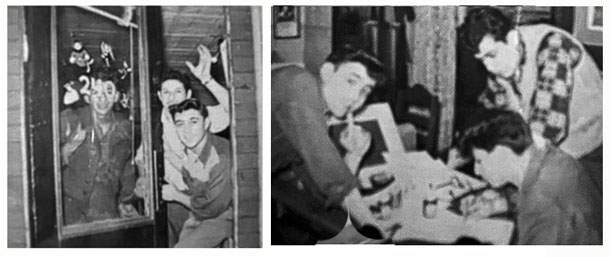
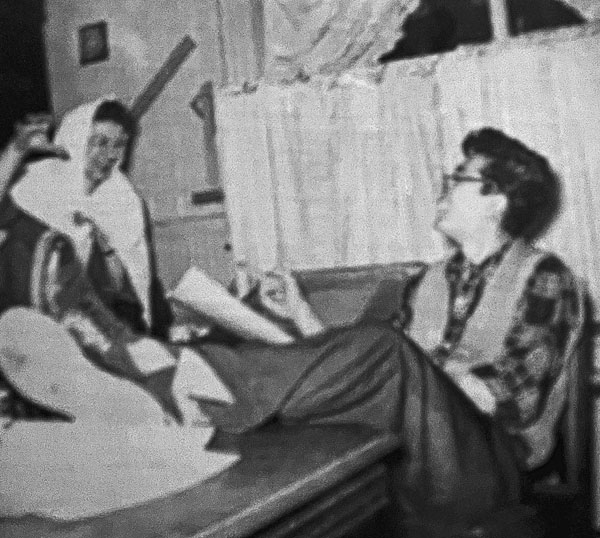
Howie Klein (wearing the glasses) would drop by and kick ideas around. Dante asked a friend taking woodshop to build them a couple animation tables. Garber’s Art Supply on 79th Street, near the school, was a source for odds-and-ends.
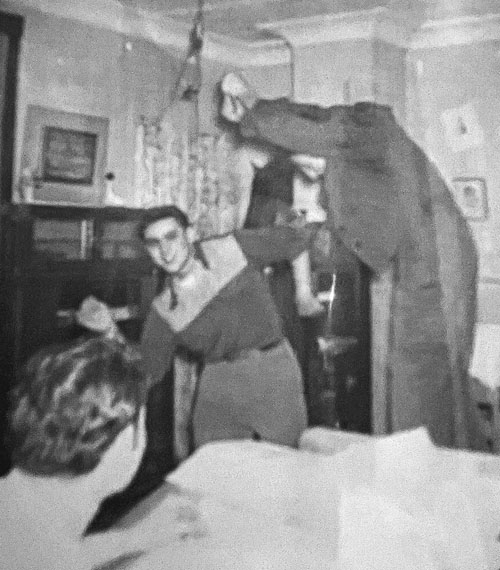
SEEN HERE: Dante sketches away while Phil and Pablo act out a scene from the cartoon they would make, a simple story about a little ghost.
Cels were too expensive, so animation was done on paper using a peg system they’d devised.
The fellows did create a few finished cels as proof they understood the concept. A storyboard wall was set up. Everyone in the shop did a little bit of everything.
Pablo and Phil were in an escalating cycle of subway trips between school, home and Brooklyn.
Dante used the subway less. His home and screen printing job were both short hikes from the studio. When he found time, Dante sometimes rode into Manhattan to show his portfolio around. A bunch of top Disney animators were scattered around little shops in the Times Square area: Shamus Culhane; Lars Calonius; Lee Blair . . . a long list. Dante didn’t have to go to Disney, it was coming to him.
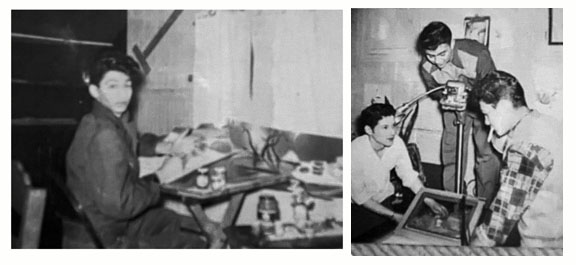
Disney veteran Dave Hilberman ran Tempo Productions at 588 Fifth Ave. Dante applied there. The influence of Bill Tytla’s style on Dante’s work was so evident that Tempo’s animation director, Bill Tytla, was called over to see it. It would not be the last time Dante would meet one of his heroes.
Things went differently when Dante entered 25 West 45th for a drop-in interview at Famous Studios. The receptionist in the hallway was very rude. She wouldn’t allow him inside to speak with anybody. Dante pleaded with her, explaining he’d come a long way on a day off from work. The receptionist, seeming to loosen up a bit, told Dante to push a button on the wall. He eagerly did so. The elevator doors opened. That receptionist told Dante to get on and not come back.
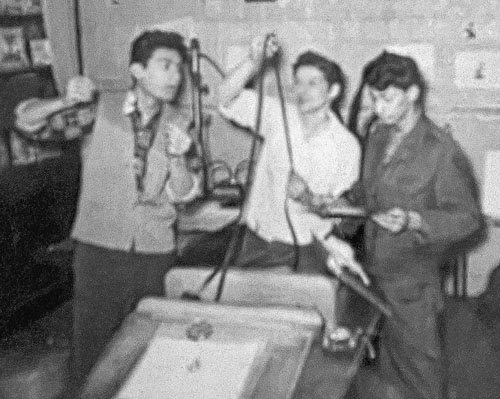
Well, perhaps Pablo hadn’t spent much time thinking on animation before meeting Dante, but he was thinking on it now! Exposure to foreign cinema at the theater where he worked set those wheels in Pablo Ferro’s hyper-active head turning in multiple directions. The projectionist sometimes snipped frames out of animated films for Pablo to examine. Pablo wanted to break off into a looser style. Dante swore by the tried-and-true Disney method. Phil, with an eye on the progression of TV commercials, saw merit in both points of view.
Friends from school included Carol Ricker, who would become an inker in the business, and Agnes Hazel Allen, later an animation designer. Dave Ubinas, another student at the school, visited the studio on occasion. Ubinas would put in time at Terrytoons and Famous Studios.
Dante and Pablo found a kit used for shooting movie titles, and adapted it into an animation camera stand. Photographing each drawing in sequence was a tedious task, but they would be able to see what their months of hard work had achieved.
As it turned out, the camera had been incorrectly mounted to the rostrum, causing the whole film to be upside down in the projector. They could have re-photographed it, but graduation came along. The studio closed. The film and the artwork have been lost. So we are left with only these photos as proof of the thing.
Early that summer Famous Studios held a test to find new talent. Here’s where things get sketchy, so to speak. Dante Barbetta remembers meeting Phil Kimmrlman outside the building and taking the test together. They were both accepted as inkers. Phil recalls being on vacation in the Catskill Mountains with his family. As an aside, I want to note that Phil was notorious for doing satiric caricatures of his friends.
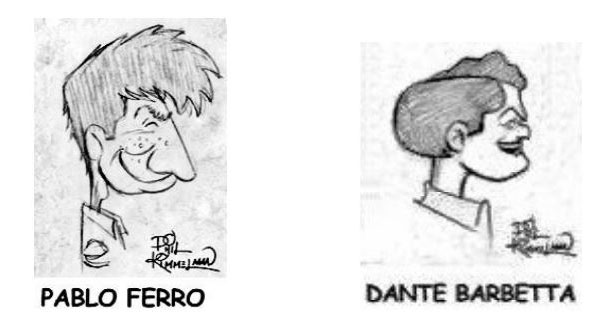
The phone rang in that Catskills bungalow the Kimmelmans rented. Pablo excitedly told Phil to get down to Manhattan right away because Famous Studios would hire him. Pablo already had the job but now he didn’t want it. Tempo Productions suddenly offered Pablo an entry level spot. He’d do errands and learn from Bill Tytla and Dave Hilberman. Tempo also had a designer named Ray Favata who thought in a very non-Disney way.
 When Pablo stopped chattering, Phil congratulated him, but didn’t plan on leaving his family vacation. Far from all that concrete and asphalt, summer in the Catskills meant swimming and hiking, lots of picnics, barbecues, handball, fireworks, and that gorgeous local girl. Neither Phil or Pablo had a car, so it would take at least three hours navigating a complex sequence of bus changes to reach the City.
When Pablo stopped chattering, Phil congratulated him, but didn’t plan on leaving his family vacation. Far from all that concrete and asphalt, summer in the Catskills meant swimming and hiking, lots of picnics, barbecues, handball, fireworks, and that gorgeous local girl. Neither Phil or Pablo had a car, so it would take at least three hours navigating a complex sequence of bus changes to reach the City.
School of Visual Arts would start soon enough, and Phil planned to get his fresh air on. Phil told Pablo he’d see him in a couple weeks. Mid-morning the next day Pablo Ferro knocked on the door of the Kimmelman family’s bungalow. He’d come the Catskills to fetch Phil, who was astonished Pablo ever found the place. After Mrs. Kimmelman fed them Phil and Pablo headed for Times Square. Pablo walked Phil into a job with Famous Studios’ inking department . . . Dante was there waiting for him. That snooty receptionist was gone.
Phil Kimmelman never used that scholarship to the School of Visual Arts. (Rudy Zamora’s nephew went instead.) Phil already found his home. Howie Klein became an attorney. In time, Carol Ricker married Ray Favata. For a while Agnes Hazel Allen was married to designer George Canatta Jr. Phil, Pablo and Dante each had a younger brother who became an animator. Here’s how Phil Kimmelman caricatured himself.

Phil and Dante bough one of those novelty gags that looked like a spilled ink bottle, setting it on a stack of finished cels when the other inkers were out to lunch. Pablo thrived at Tempo, where Bill Tytla patiently answered his barrage of questions. If Dante felt a twinge of envy at Pablo getting to apprentice under Tytla, it was soothed when the great Al Eugster became Dante’s mentor. All three of our guys advanced rapidly from inker to inbetweener, and then into the assistant animators pool. At that point much depended on catching the attention of an established animator who would take them under their wing. Al Eugster had been part of creating Betty Boop, before working on SNOW WHITE AND THE SEVEN DWARFS. He and Dante grew very close over the years.
 Phil’s patron was the more caustic Steve Muffati, a New York animator with two decades of experience. Early on, Muffati turned down a job offer from Walt Disney, telling the man to his face he didn’t think the Disney studio would last. When Phil Kimmelman, Dante Barbetta, and Pablo Ferro joined the union together that night in December of 1953, they were a burst of youthful exuberance so badly needed. The business was undergoing changes, shaking off the puberty of theatrical cartoons for the adult world of ad agencies and teleblurbs.
Phil’s patron was the more caustic Steve Muffati, a New York animator with two decades of experience. Early on, Muffati turned down a job offer from Walt Disney, telling the man to his face he didn’t think the Disney studio would last. When Phil Kimmelman, Dante Barbetta, and Pablo Ferro joined the union together that night in December of 1953, they were a burst of youthful exuberance so badly needed. The business was undergoing changes, shaking off the puberty of theatrical cartoons for the adult world of ad agencies and teleblurbs.
Famous Studios would have already caught wind of these three remarkable young artists. The trio had already threatened to start yet another competitive commercial studio, after laying the groundwork for animation classes at the High School of Industrial Arts. People in front offices knew their names. Dante Barbetta spent the next two decades doing theatrical cartoons at Famous. In off-season he freelanced for people like Shamus Culhane and Preston Blair. Upon the demise of Famous Studios, Dante worked on a feature-length movie to help open the road for computer assisted animation. Phil Kimmelman rose through the ranks of the indie shops to head his own, surrounding himself with top talent, including his two friends. Pablo Ferro detonated across Sixties subculture.
We’ll explore the individual careers of each in upcoming articles. Whatever happened to that upside down ghost remains a mystery.


 BOB COAR made his way in this world as a muralist and sign painter, illustrating on just about every surface imaginable. A life-long fan of animation, he is currently searching for digital, or actual, copies of Top Cel.
BOB COAR made his way in this world as a muralist and sign painter, illustrating on just about every surface imaginable. A life-long fan of animation, he is currently searching for digital, or actual, copies of Top Cel. 



































I do indeed remember stationary stores, and even today most stores are stationary, but I think you mean a stationery store, or what we in Commonwealth countries call a stationer’s. My mother, who was a secretary, gave me a very hard time the one and only time I ever made that spelling mistake. Likewise the one and only time I misspelled “secretary”.
I know the tragic story of Tempo, and it’s a shame that after all his excitement at having obtained his dream job there, Pablo Ferro wouldn’t last very long at the company — and neither would anybody else.
So animators in 1980 had piles of money and gorgeous girls, eh? That Phil Kimmelman had some imagination!
Paul Ferro’s story is turning out to be quite interesting to me, being of Cuban descent myself. I’d like to know about any other Cuban immigrants to the US who worked in the commercial arts (especially animation in general) before the likes of Antonio Prohias (creator of MAD magazine’s Spy vs. Spy) fled the country in the mass exodus that followed Castro’s ruthless takeover. I would imagine a majority of them weren’t just located in New York, but also around southern Florida as well (seeing as the Fleischers once had a studio there), and perhaps even a scattering of them in the LA area.
I presume that around this time, there was no passenger train service to the Catskills available, seeing as the area was still developing into a major resort destination that would in time lure seniors and major name comedians into it’s lush environment. But there was a light craft airfield in the area at that time. If Kimmelman had enough to afford it, he could’ve splurged to take a charter flight from the Catskillls to nearby Teterboro Airport where he could take an express bus or taxi into NYC.
I notice the facial features of Barbetta’s caricature nearly resembles Popeye’s, which leads me to believe Kimmelman must’ve been working on that series at Famous at the time. Also, I can’t help but wonder if that “snooty receptionist” was ever caricatured in one of Famous’ cartoons, perhaps in a Noveltoon or Modern Madcap. (I’m thinking the one in “Spooking Of Ghosts”, but that’s purely speculation on my part.) Oh, and about that “simple story about a little ghost” they came up with: I know Casper was already an established character at Famous by then, so it seems that part of their story represents a bit of foreshadowing for the immediate future of these three promisingly talented young men.
There are two photos of Dante Barbetta at Famous Studios.
https://sites.google.com/site/aleugster/home/eugster-s-photo-album—famous-studios-1956
https://sites.google.com/site/aleugster/home/eugster-s-photo-album—famous-studios-christmas-party-1954
From the reception’s attitude, you’d think Famous Studios was making quality cartoons. “Dante Dreamer” (some coincidence, huh?) is one of the better ones.
While it may be true many disparage the quality of the cartoons being dispensed by Famous Studios, I suspect few would speak ill of the skills of the talent pool there. `